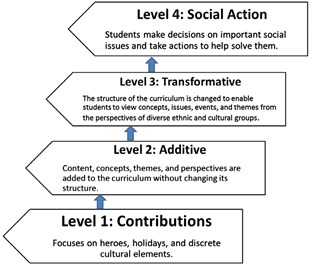When I think back on all of my years of K-12 schooling, the only diversity included in the curriculum (if you can even call it that) were the ubiquitous studies of westward expansion, slavery, civil rights and a few prominent figures that emerged from those time periods. What I took away, as a young person of color, was that the influence and contributions of people like me were relegated to the margins of history. An additive to the mainstream narrative.
As classrooms in the U.S. continue growing in diversity, teachers are tasked with creating a more inclusive curriculum to reflect the voices and perspectives of a broader spectrum of people. By teaching the established curriculum, minority students often feel disengaged and unempowered resulting in lower levels of achievement. But when educators work to create a set of curricula that is relevant, meaningful, and affirming to diverse identities, their efforts result in positive outcomes both socially and academically. Research also shows that not only students of color, but white students greatly benefit from a diverse curriculum as the exposure enables them to grapple with multiple perspectives and build a better understanding of both self and others.
We know the struggle: teachers are doing the best they can with the time and resources they’ve been given and we know the work that it takes to locate and review diverse materials. Re-writing an entire unit of study can be challenging and oftentimes prevent teachers from digging into the work they know is necessary. To help make the process easier, we’ve outlined the most critical considerations for creating a diverse curriculum and offer a few resources to start you on the right path towards a more inclusive learning experience for your students.
1. Analyze Your Curriculum

What level of diversity integration do you currently observe in your curriculum? Are there gaps? What are they? Scholar James Banks developed the 4 stages of multicultural education to help guide educators from an “add on” approach to one that places multiple (and marginalized) perspectives at the center. An initial evaluation of your curriculum can help determine your starting point and guide your work towards a more transformed and socially conscious curriculum. To read about each level in greater detail, read through the Levels of Integration of Multicultural Content: A Brief Summary.
2. Make a plan
As outlined in Level 3 of Banks’ graphic, the ideal curriculum is one that challenges the established structure and content such that several perspectives are explored. It engages students in critical thinking and encourages participation in social change efforts. A great place to start is to consider how can you restructure and integrate content from underrepresented groups into the curriculum. Here are a few resources to help:
- Key Characteristics of a Multicultural Curriculum
- Facing History and Ourselves: Resource Collection
- The Zinn Education Project: Teaching People’s History
3. Go deeper to encourage social action
As you consider changes to curricular materials and content, adding in related social concepts and issues is essential. If we want our students to become responsible citizens with the knowledge and skills to navigate any situation with people who think and look different than themselves, then we must teach relevant skills such as asking critical questions, checking for bias, holding respectful discussions, and affirming the lived experiences of others. The websites below provide ideas and structure for your social action initiative:
- Teaching Tolerance Lesson Resources
- DoSomething.org
- GLSEN: Educator Resources
- Global Oneness Project
4. Consider the learning environment
Curriculum goes beyond what’s in the textbook or the learning activities presented to students. The curriculum should extend to the physical space students are surrounded by every day. Do me a favor. Step into the hallway and re-enter your classroom with an inclusive lens. Does your classroom space represent the diversity within your classroom or school? Are multiple identities, cultures, and perspectives visible? An often overlooked aspect of the learning environment is the physical space. Changing the curriculum to be more inclusive also means opening up student dialogue, changing what you put on the walls and what’s on your library shelves. Check out these resources to help you create a more inclusive classroom:
- Creating a Diverse Classroom Library: The Windows and Mirrors Model
- Cultivating a Culturally Responsive Classroom Community
- Gender Savvy: Creating an Inclusive School Climate
- One World Downloadable Posters from Teaching Tolerance
Poet and Author, Maya Angelou put it best when she said, “Do the best you can until you know better. Then when you know better, do better.” It’s time to do better for all of our students by integrating new materials, perspectives, and voices to provide a more complete and accurate curriculum. The journey towards a more inclusive, diverse curriculum starts with you! Now go do better!






